In order to keep things in the dressing room in normal conditions, so that there are no problems with odors and dampness, you need good ventilation. You can hardly do without it. Closet ventilation is not the most complicated system, but you also need to know how it can be arranged.
Artikkelens innhold
Why ventilation is needed and its types
In the storage areas of things and shoes, it is necessarily necessary to organize a good air exchange. On things and shoes retain skin particles, skin secretions remain, dust accumulates. All this is an excellent environment for the development of microorganisms. Therefore, good ventilation in the dressing room is a prerequisite for maintaining the normal state of things and the absence of musty odor.
In dressing rooms, as in any other rooms, ventilation can be natural and forced. Natural ventilation works due to physical processes – cold air comes from below, heats up and rises to the top. Therefore, if you make the bottom of the inflow hole, and the top – exhaust, will provide air movement at a certain speed.
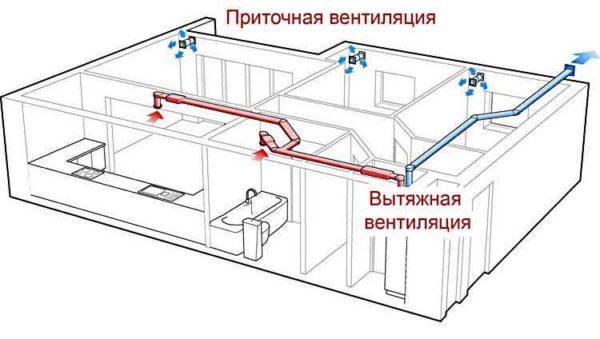
If near the dressing room there are ventilation channels, it makes sense to make a branch to the exhaust vent. This will solve many problems.
But natural ventilation of the dressing room is not always able to provide sufficient air exchange rate. To increase it, fans are put fans. They can be installed both in the supply and exhaust openings. Most often there is a forced exhaust, and the air supply occurs naturally through ventilation gaps or holes. This allows you to spend not too much money, but ensure a normal atmosphere in the room.
How to make ventilation in a dressing room without windows
Mostly dressing rooms are arranged in small rooms without windows. In this case, it is not necessary to hope for an air inflow through the cracks. It is necessary to make openings. The air inlet can be provided through:
The size of the air inlets depends on the volume of the room and the velocity of the air masses. According to the regulations, dressing rooms for storing clothes should have a single air exchange. For example, if your dressing room has dimensions 1,5*2,0*2,8 (width, length, height), then its volume (is found by multiplying all figures) 8,4 cubic meters. For an hour, to maintain a normal atmosphere, it is necessary to “pump” 8.4 cubic meters of air. So the ventilation of the dressing room will prevent the appearance of foreign odors.
If the ventilation works normally in the apartment, for these purposes it is enough to make a supply hole with a size of 100*100 mm. Cross-section – round, square, rectangular – it does not matter. The main thing is that its area remains the same or larger. And in general, this parameter is counted or found on the table. But the tables show much larger volumes.

But the ventilation of the dressing room will work normally, provided that there is an exhaust channel. This can be a similar grille in the wall. It should be located on the opposite wall from the inflow hole closer to the ceiling. And you should try to spread these holes as far apart as possible – so that the air flow covers as large an area as possible.
If the inlet opening is made in the door, and the door – in the middle of the width of the room, it is worth installing two exhaust grilles – on the right and left, 15-25 cm away from the corners.
Where should the exhaust grilles go? In the best case – into the ventilation duct. A possible option is to go outside, if one or more walls of the dressing room face the street. In this case, you can put the supply duct outside and the exhaust duct into the ventilation or any of the adjoining rooms.
If there are windows
If there is a window in the dressing room, there will be fewer problems with the supply ventilation. If the windows are leaky, natural inflow is usually enough. But if there are plastic windows, it is possible to provide access to fresh air only through ventilation. In this case, it is ideal if there is a micro-ventilation function. By providing a small air supply for some time, a normal atmosphere can be maintained.
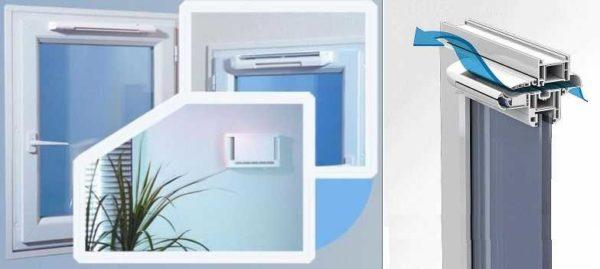
If plastic windows have only standard modes, just below the window sill, on the side of the window or anywhere on the wall, you can build in valves to bring in air from the street. These dampers are usually adjustable and can let air in at different rates.

Depending on the manufacturer, the inside can be round (as in the picture on the left) or rectangular (as in the picture on the right). Their construction is approximately the same. – filter, insulation, external and internal grids. A very convenient thing not only for the supply ventilation of the dressing room, but also all other rooms, the walls of which face the street.
Whether you need a fan
As we have already said, natural ventilation of the dressing room does not always provide sufficient air velocity and musty odor still appears. This usually happens in the summer, when it is too hot outside and the natural air movement is minimal or there is a draft reversal (air masses moving in the opposite direction). In such cases, fans are installed on the exhaust openings. Their power is selected depending on the volume, but as a rule, the lowest-powered ones – 10-50 cubic meters per hour – are enough. In this case, the main criterion of choice is the quietness of operation. After all, many dressing rooms go into bedrooms or other living quarters.

Many people are frightened by the installation of fans – they must work almost around the clock. In general, it is not necessary. It is quite enough if it is turned on for 15-20-30 minutes every hour. This mode is provided by timers, controllers and other similar devices. All that is required is to select the mode of operation and set the appropriate settings.
Yes, this is an additional cost, but forced ventilation of the dressing room works constantly and does not depend on the vagaries of the weather.
For quietness
If you install ordinary grilles in the dressing room on both opposite walls, noises will penetrate through them. Clothes and space will muffle them somewhat, but some sounds will be heard. If you are not frightened by this prospect – great. But if you want silence, special bypass grilles or valves are put in the holes.
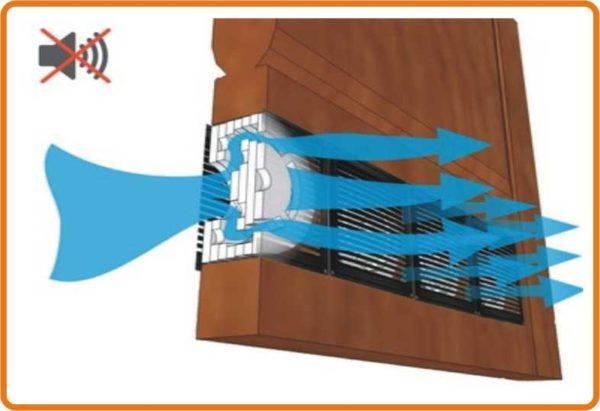
They almost do not prevent the passage of air, but they do not let in light and noise. These grilles are not cheap, but there is no other way to make the closet ventilation effective and at the same time do not let sounds through.
Lighting in the dressing room
A walk-in closet is not a closet. It’s a room where you can walk in undressed and walk out fully clothed. The presence of a large number of shelves, drawers and cabinets requires good lighting. After all, only in bright light you can see everything you need without strain and evaluate in the mirror the combination of selected clothes.
For normal illumination in the dressing room usually make multi-zone lighting. Part of the lights are located on the ceiling. If the ceiling is suspended, built-in lamps with a large angle of dispersion are suitable. If the ceiling is ordinary – bleached or painted, select ceiling lamps or chandeliers of small height. Convenient in this case, models with rotating plafonds – beams of light can be directed where required.
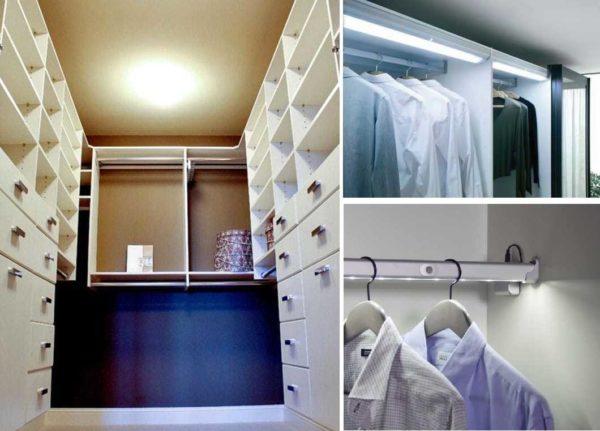
It is desirable to illuminate the mirror separately. In this area you can use sconces or tubular lamps. The same – long and thin – you can place lamps over the pipes on which the hangers are located, over large shelves. In general, there are a lot of lights. That they do not greatly affect the payment for electricity, it is best to take LED. These can be tapes, sections, lamps, lamps with a standard or small base. The shape is not important. It is important that they “pull” very little electricity, have a long life and at the same time almost no heat.
Another way to save money is to think about the lighting system at the planning stage of the dressing room, dividing the lights into groups and putting them on the switches separately. Whichever group you need, you turn them on.
If you don’t like looking for on/off switches, you can install motion detectors. They will turn on the lights when there is movement. Also quite convenient and economical. But in this case you need to set a more solid delay for turning off the lights. Otherwise you will freeze in front of the mirror, for example, and the light will go out.

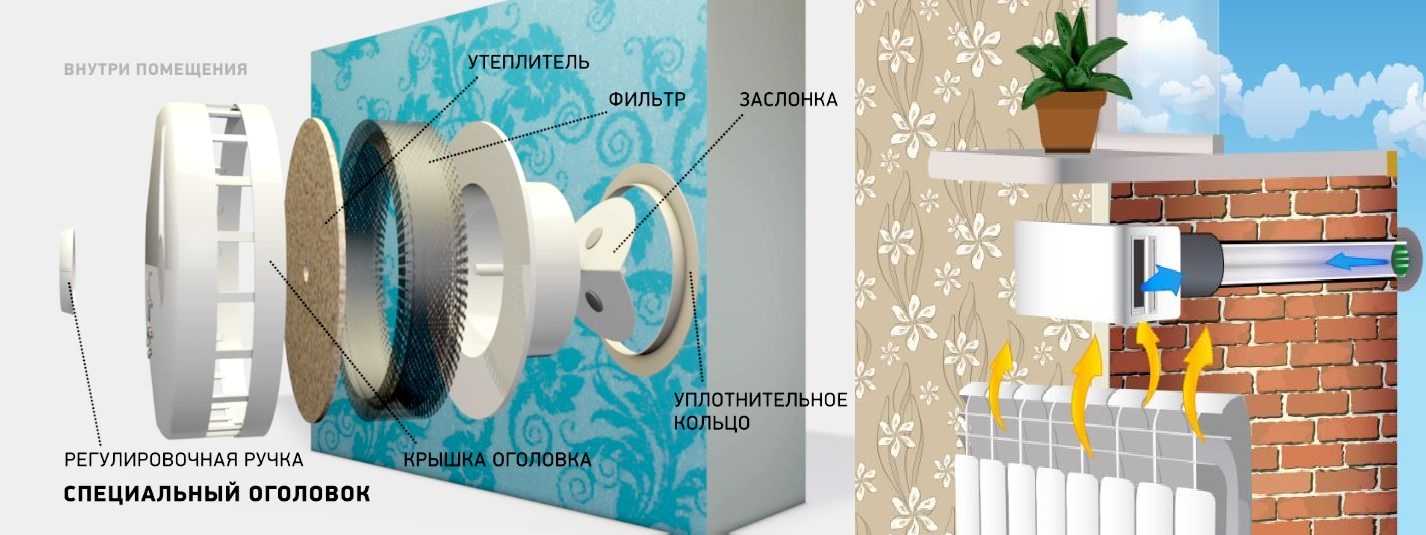
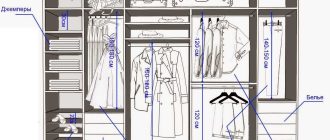
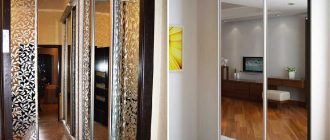

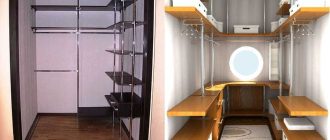


Setting up my dressing room was a game-changer! I added a small window for natural light and used some LED strip lights for a cozy vibe. For ventilation, a couple of small fans did the trick to keep it fresh and breezy. Now it’s my favorite space!